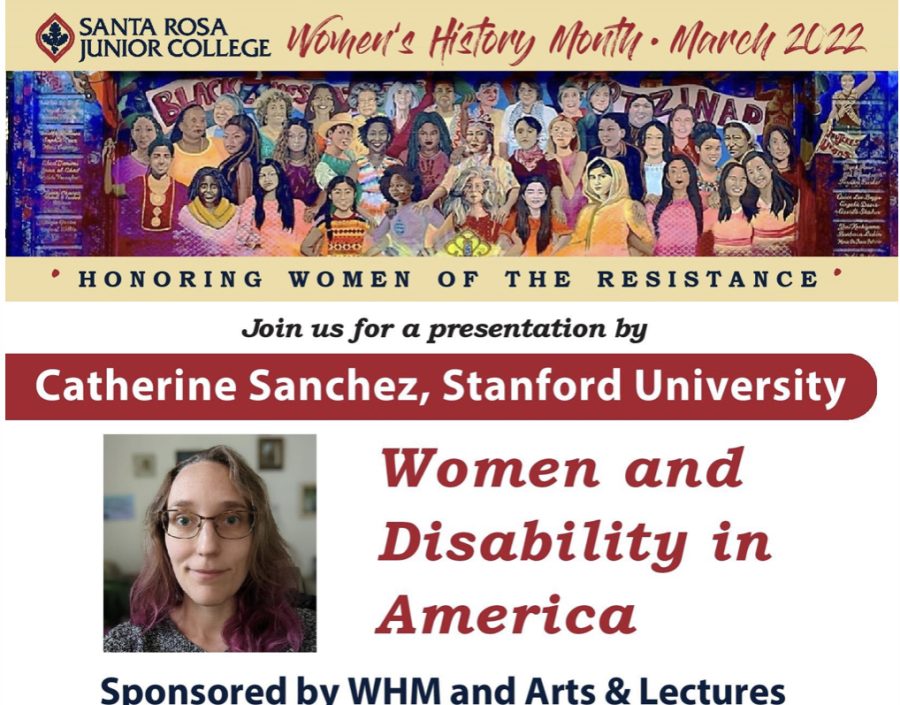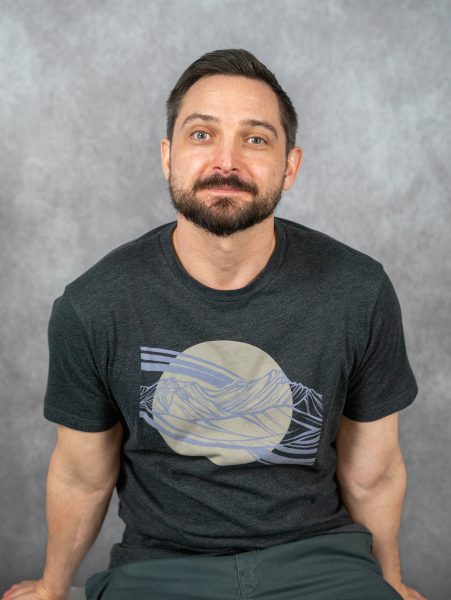Content warning: this story contains brief mention of sexual assault.
A Stanford University assistant dean spoke to Santa Rosa Junior College students about the women behind the disability rights movement in America on Zoom on March 14.
The SRJC Women’s History Month Committee and the SRJC Arts and Lecture Committee co-sponsored the Women and Disability in America event to celebrate Women’s History Month.
Disability Resource Specialist and Women’s History Month Committee member Laura Aspinall introduced speaker Catherine Sanchez, Stanford University assistant dean of students in the office of community standards. Sanchez has earned a bachelor’s degree in human biology and a master’s degree in sociology at Stanford University.
“As an administrator, Cat continues her advocacy work for the disabled community, including advising students hosting disability related talks and helping to create a disability community space on campus,” Aspinall said.
Sanchez said in order to understand the disabled experience of today, we have to understand what it was like in the past. Disabled people have always been active in our society, yet their disabled narrative often isn’t shared, she said. One such historical figure is Harriet Tubman, who is well known for her work on the Underground Railroad, yet few are aware she was epileptic since she was teenager.
“We only hear a story of heroism, but we don’t hear what her life as a disabled person was like as she was carrying on her incredible work,” Sanchez said.
By omitting the disabled narrative from historical figures, we silence disabled members of modern society, she said, especially those with multiple marginalized identities.
According to Sanchez, Western society has two main models of viewing disability: individual and social. The individual model views disability as belonging to the individual who needs to be cured or fixed in order to function in society, while in the social model disability occurs when society doesn’t accommodate the needs of the individual.
Sanchez said disabled narratives have been hidden from U.S. society since the colonists, who brought the individual model view from Europe where disability was seen as a fact of life. At that time, she said many disabled people were locked away from view by their families or forced by the community to move away or live in workhouses for criminals; a practice echoed today, when many unhoused or incarcerated individuals suffer from mental disabilities.
Shunning disabled people progressed from community practice to our nation’s laws, Sanchez said. Slavers used mental disability to justify their inhumane treatment of slaves, and attributed escape attempts to mental illness, calling it “drapetomania.” After the Civil War, when many soldiers came home disabled or maimed, cities across the U.S. passed “ugly laws,” which forbade unsightly people from being in public view.
When we separate disabled people from society, we also pitfall into defining historical figures by their disability rather than their achievements. Sanchez contrasted Tubman to Helen Keller who is more known for becoming a successful author after she overcame her deafness and blindness, instead of her disability rights activism, like helping found the American Civil Liberties Union.
“With Tubman we get her activism and almost none of her disability experience. With Keller we get her disability and none of her activism,” Sanchez said.
Sanchez said Keller was a complicated figure because, while she fought for disabled rights, at one time she supported refusing medical care for babies born with severe disabilities, which she eventually changed her mind on.
“It’s important that we understand people as their whole selves and include this in her story,” she said. “Ableism, like other forms of bigotry, is an action. We are all complicit in ableist systems and we can all perform ableist acts, but there’s not inherently negative ableists. Our stories are more complicated than that.”
Keller’s views against severe disabilities were influenced by the popular theory of the time, eugenics, which encourages some people to procreate and prevents others from doing so based on perceived superior and inferior genetic qualities, Sanchez said.
The eugenics ideology led to the forced sterilization of many disabled people in America, Sanchez said. The first documented victim of forced sterilization was Carrie Buck, who was committed to the Virginia State Colony of Epileptics and Feebleminded by her foster parents after being raped by her foster mother’s nephew. The superintendent selected her for sterilization to test a new state law that protected doctors who sterilize people with intellectual disabilities without their consent for eugenics purposes. His decision was upheld in court.
“The 1927 Supreme Court ruling on this case set the tone for the treatment of disabled people in our country for decades, and for the treatment of multiple or severely disabled people up to our current times,” Sanchez said.
Another victim of forced sterilization was Betty Lou Hammer, who became disabled after receiving a beating in jail. Hammer is known for her voting rights activism and organizing the Mississippi Freedom Rights Summer. She was sterilized in jail, which was common among Black women at the time. She coined the term “Mississippi Appendectomy,” because women were told they were getting a medical procedure but were sterilized without their consent while they were under anesthesia.
Sanchez said the disability rights movement of the 1960s was backed mainly by polio survivors of the 1940s and ‘50s polio epidemic, who fought for equal access to education. A major figure in this movement was Johnnie Lacy, who co-founded the Berkeley Center for Independent Living: one of the bedrocks in the disability rights movement.
As a Black woman, Lacy had to fight to pursue higher education at San Francisco State University and wasn’t allowed to be officially part of the university when taking classes and couldn’t participate in graduation, Sanchez said. One of the first activists to mention intersectional discrimination, Lacy didn’t feel she belonged to either the Black or disabled communities, which is an experience many disabled people of color experience today.
“Disability is a very intersectional identity, and I think it’s important that when we think of these types of efforts, we’re also thinking of disability, and the ways that it’s interacting with these other types of identities,” Sanchez said.
In the modern era, Sanchez said, one of the ways disabled people are separated from society is through fashion, as clothing is rarely made to fit a variety of bodies. She said female beauty is often viewed as symbolic to a woman’s reproductive ability and worth, and disabled mothers are at a higher risk of having their children taken from them in court.
When we perpetuate the idea that disabilities are ugly and shameful, people feel uncomfortable talking about them, Sanchez said, which leads to similar lines of thinking as colorblind racism.
“Colorblind bigotry tends to show up in the disability context as a desire to leave our disabilities unspoken, unshared and unshown,” Sanchez said.
Jillian Mercado, queer and disabled British model and actress, advocates against people hiding their disabilities, Sanchez said. In an interview with Fashionista Magazine, Mercado said the only time she saw disabled people while growing up was in commercials about cancer, which made her self-conscious about her disability. Now Mercado has a large social media following and works to promote more representation and self love.
Sanchez finished her talk by answering questions from attendees. One question was “what is the difference between equity and equality?”
Sanchez used an example of three people of different heights trying to look over a wall to watch a baseball game. One person is tall enough to look over the wall, one is almost tall enough to look over and one is not nearly tall enough to look over. Equality would be treating them all equal by giving each a stepping stool of the same height. The problem is the stepping stool would only benefit one person: the one who is almost tall enough to look over the wall. Equity would be recognizing that each person is different and providing appropriate accommodations so that all three can watch the game with the same level of comfort.
Another question asked was “how can I make the classroom or workspace more inclusive and accessible?”
“I would try to look for ways that you can include what is called universal design, which is finding multiple ways to make things accessible to people. For example, if you are presenting materials to your class that are PDFs, then make sure that they’re accessible via a screen reader,” Sanchez said.
She also said students can get ideas by contacting SRJC disability services.





Mary Combs • Apr 13, 2022 at 10:37 am
Great article. It gave me pause
and a lot to think about.
The laws and forced sterilization are abhorrent. Hopefully as a nation we are recognizing the need to change our perception of all people with disabilities. It is good that there are movements addressing these issues.